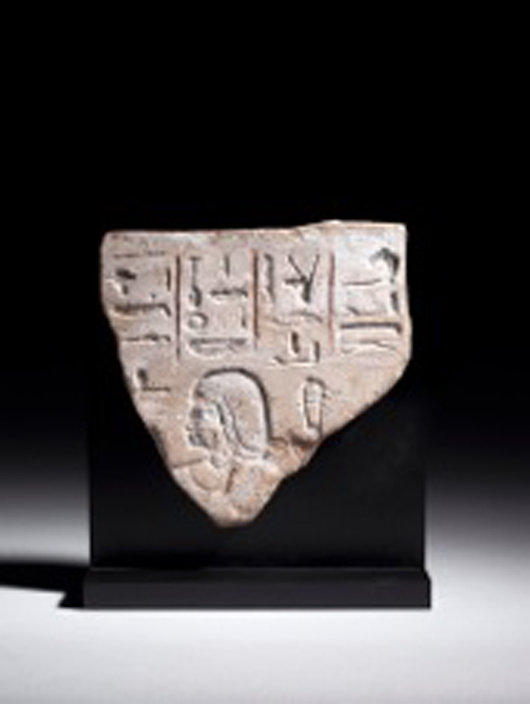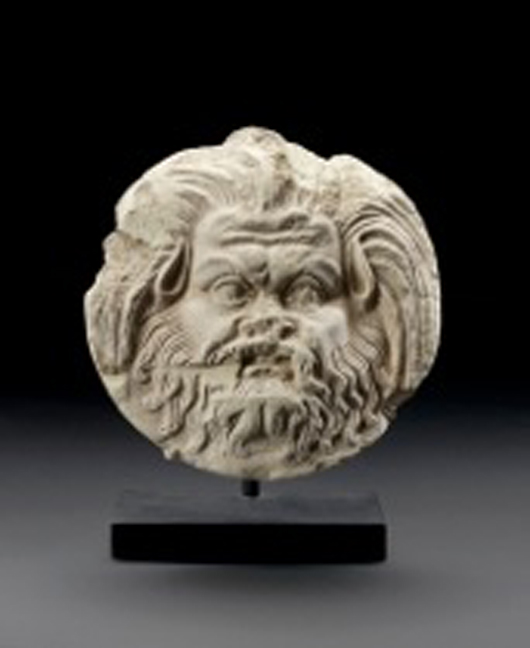
Not so long ago, most important Chinese imperial works of art emerging from UK private collections would have been consigned to a London auction house. It has been that way for almost 200 years, but not any more. The internet has changed everything.
“There is no such thing as the London market,” Clare Durham of the Salisbury auction house Woolley and Wallis told Auction Central News today after her firm’s sale of Asian Art on Nov. 16 saw another strong showing from Asian buyers. “With the internet there is no reason why something should make more in London than anywhere else,” said Durham, whose West Country firm now represents serious competition to London hammers, particularly for important consignments in the booming category of Asian art.
The most striking illustration of this new state of affairs was a hammer price of £400,000 ($630,535) offered by a Chinese bidder at the Salisbury sale for a Qing Dynasty Imperial gold box looted by a British officer from the Summer Palace in Beijing in 1860. The box had been estimated at £50,000-80,000. It was immediately followed by a superb pair of Qing Dynasty cloisonné vases  that shattered a forecast of £100,000-200,000 to bring £360,000 ($567,525).
that shattered a forecast of £100,000-200,000 to bring £360,000 ($567,525).
However, although the web has leveled the playing field between London and the better provincial auction houses, bidding via the Internet was not available at Woolley & Wallis’s sale but confined to the paddles in the room and 17 telephones laid on for the purpose. Durham confirmed that the decision to suspend the Internet facility, and to vet bidders and request presale deposits on “premium lots” such the gold box, reflects a continuing need to protect vendor’s interests where expensive, or culturally sensitive material is concerned.
The gold box is one of a number of items sold in the UK recently that were looted from the Summer Palace during the Opium Wars between Britain and China in the 19th century. The box was even candidly inscribed, ‘Loot from the Summer Palace, Pekin, Oct. 1860, Capt. James Gunter, King’s Dragoon Guards.’
“If people are genuinely interested in acquiring something, they will stump up the deposit which is often a fraction of the value of the lot,” said Durham. “This prevents people ‘taking a punt’, or the lot making too much and then not being paid for.”
The prices at Woolley & Wallis’s sale — which extended to extraordinary sums for another sizeable collection of rare Yixing red stoneware teapots  — confirmed that although the global financial crisis is still rumbling through Western economies, the Asian tiger remains on a roll. That said, this week witnessed further confirmation, if any were needed, that if an auction house can find the quality lots, even Western collectors will respond with enthusiasm.
— confirmed that although the global financial crisis is still rumbling through Western economies, the Asian tiger remains on a roll. That said, this week witnessed further confirmation, if any were needed, that if an auction house can find the quality lots, even Western collectors will respond with enthusiasm.
Take, for example, the dozen or so lots of paintings by the Modern British painter Lawrence Stephen Lowry, which came under Christie’s London hammer on Nov. 16. Lowry’s cityscapes, invariably teeming with his signature “matchstick men” scuttling to and fro, have become as recognizable a part of the English cultural furniture as warm beer or fish and chips. Like those two culinary institutions, Lowry’s paintings are also something of an acquired taste, although the subject of the star lot at Christie’s — Piccadilly Circus
— perhaps took this example of his work into a different league.
The premium-inclusive £5,641,250 ($8,890,610) — offered by a private buyer and equaling the record price for the artist auction — surely confirmed that fine art remains a favourable investment option for the wealthy during times of economic uncertainty. Interestingly, all of the top three Lowry lots at the sale, each of which exceeded £2 million, were secured by private collectors.
London auctioneers Bonhams have been enjoying a lively start to the autumn season, last week securing one of the most significant prices of the recent capital-wide ‘Asian Art London’ event. Their sale on Nov. 10 saw £9,001,250 ($14.1 million) change hands for a magnificent Qianlong famille rose turquoise ground vase decorated with chrysanthemums,
a price that brought rapturous applause from a packed saleroom. It also allowed Bonhams to claim the highest total of this year’s Asian art auction series in London and the most favorable sold percentages too.
Now all eyes turn toward Bonhams’ Old Masters sale in December, which will unveil one of the most exciting Old Master discoveries for quite some time — a previously unrecorded portrait by Velasquez (1599-1660).
One need only glance at a high-resolution image of this painting to appreciate why it justified the provenance research and the extensive scientific analysis lavished upon it since its discovery as part of a consignment to Bonhams’ Oxford rooms in August 2010.
The bust-length Portrait of a Gentleman was entered for sale among a number of works by the little-known 19th-century painter Matthew Shepperson, but its manifest quality soon had the connoisseurial adrenaline flowing. Like many artists, Shepperson was also something of a collector and it now seems the Velasquez portrait was one of his more discerning purchases.
Velasquez was, of course, responsible for an epochal moment in the development of the 20th-century art market when his portrait of his servant and workshop assistant Juan de Pareja set a new benchmark for art prices at Christie’s London in 1970. The painting was bought by Alec Wildenstein for an unprecedented 2,200 guineas — the equivalent of around £27.8 million ($43.8m) today. It is now in the Metropolitan Museum of Art.
It seems unlikely that Bonhams’ Velasquez will scale such dizzy heights, not least because despite the artist often being cited as the favorite painter of connoisseurs, curators and art historians, few museums today can compete with open market price levels. Portrait of a Gentleman carries a speculative estimate at Bonhams of £2,000,000-£3,000,000 ($3.1m-$4.7m), but come sale day anything could happen.
“Anything could happen” might have been the phrase on many lips at Tayler & Fletcher’s salerooms in Cheltenham a couple of weeks ago where a watercolor by Swedish artist Anders Leonard Zorn (1860-1920), came under the hammer.
The Letter, cataloged as “a previously unrecorded and fresh-to-the-market composition, possibly of English model Mary Smith, “was signed and dated “82.” Believed to have originated from Zorn’s Brook Street, Mayfair studio, the gilt framed and glazed portrait had been acquired by the vendor’s family directly from the Empress of Austria who, we are told, visited Sweden on many occasions. This illustrious provenance, supported by a certificate of authentication from Professor Johan Cederlund, director of the Zorn Museum in Mora, Sweden, can only have helped the painting soar up to a hammer price of £82,000 ($129,200).
cataloged as “a previously unrecorded and fresh-to-the-market composition, possibly of English model Mary Smith, “was signed and dated “82.” Believed to have originated from Zorn’s Brook Street, Mayfair studio, the gilt framed and glazed portrait had been acquired by the vendor’s family directly from the Empress of Austria who, we are told, visited Sweden on many occasions. This illustrious provenance, supported by a certificate of authentication from Professor Johan Cederlund, director of the Zorn Museum in Mora, Sweden, can only have helped the painting soar up to a hammer price of £82,000 ($129,200).
And so finally to the Christmas season, which despite the recession—(or perhaps because of it—is eliciting expressions of unbounded optimism from economic forecasters who predict a consumer shopping bonanza. Such clairvoyance might seem horribly wide of the mark to those struggling to make ends meet, but one person hoping his customers will have some spare cash to spend this year is London antiquities dealer James Ede of Charles Ede Ltd. Ede has just published his Christmas catalog, which contains plenty of relatively affordable gems. One stresses the word “relatively.”
The catalog features 63 works of art ranging from pottery, sculpture, Roman glass and Egyptian miscellanea with prices from as little as £50 up to £5,000, with the majority costing under £1,000.
Typical of the kind of thing on offer is a fragment of an Egyptian sandstone relief, circa 1400 B.C., which is for sale at £4,800 ($7,500),

and a very decorative fifth-century B.C. terracotta circular antefix (a carved roof ornament that hides the joint between tiles),

decorated with the head of a satyr with flowing hair, pointed ears and a wavy beard. Originating from the collection of Hollywood actor Julian Sands, this is priced at £2,800 ($4,400).
Fortunate indeed are those whose gifts from Santa will include Greek and Egyptian antiquities, particularly as the Western economies teeter on the brink of oblivion.

